Physicochemical and Sensorial Characterization of Artisanal Pasta from the Occitanie Region in France
Abstract
1. Introduction
2. Material and Methods
2.1. Raw Materials
2.2. Physicochemical Characterization of Dry Pasta
2.3. Physciochemical Characterization of Cooked Pasta
2.3.1. Cooking Behavior of the Pasta
2.3.2. Texture Analyses
2.3.3. Protein Content and Protein Profile of Freeze-Dried Cooked Pasta
2.3.4. In Vitro Pasta Digestibility Tests
2.4. Sensory Analysis
2.4.1. Descriptive Sensory Analysis
2.4.2. Ranking Test
2.5. Statistical Analyses
3. Results
3.1. Dry Pasta Characterization
3.2. Cooking Behavior of the Pasta
3.3. Protein Profile and Protein In Vitro Digestion
3.4. Correlation between Parameters
3.5. Sensory (Pivot Profile) Analysis
3.6. Sensory Appreciation
4. Discussion
5. Conclusions
Author Contributions
Funding
Institutional Review Board Statement
Informed Consent Statement
Data Availability Statement
Acknowledgments
Conflicts of Interest
References
- Agriculture Ministry. Ministère de l’Agriculture Décret N°55-1175 Du 31 Août 1955; Agriculture Ministry: Paris, France, 1997. [Google Scholar]
- Codex Alimentarius. Norme Pour la Semoule et la Farine de Blé Dur; Codex Alimentarius 1991, CXS 178; FAO: Rome, Italy, 2019. [Google Scholar]
- Feldmann, C.; Hamm, U. Consumers’ perceptions and preferences for local food: A review. Food Qual. Prefer. 2015, 40, 152–164. [Google Scholar] [CrossRef]
- EIP-AGRI. Focus Group on Innovative Short Food Supply Chain Management: Final Report; EIP-AGRI: Brussels, Belgium, 2015. [Google Scholar]
- Bresciani, A.; Pagani, M.A.; Marti, A. Pasta-Making Process: A Narrative Review on the Relation between Process Variables and Pasta Quality. Foods 2022, 11, 256. [Google Scholar] [CrossRef]
- Union of Organisations of Manufacturers of Pasta Products in the European Union. Statics-World Pasta Production. Available online: https://www.pasta-unafpa.org/newt/unafpa/default.aspx?IDCONTENT=102 (accessed on 5 May 2022).
- Chiffoleau, Y.; Echchatbi, A.; Rod, J.; Gey, L.; Akermann, G.; Desclaux, D.; Jard, G.; Kessari, M.; Moinet, K.; Peres, J.; et al. Quand l’innovation sociale réoriente l’innovation technologique dans les systèmes agroalimentaires: Le cas des chaînes locales autour des blés. Innovations 2021, 64, 41–63. [Google Scholar] [CrossRef]
- Chiffoleau, Y.; Desclaux, D. Participatory plant breeding: The best way to breed for sustainable agriculture? Int. J. Agric. Sustain. 2006, 4, 119–130. [Google Scholar] [CrossRef]
- Sacchetti, G.; Cocco, G.; Cocco, D.; Neri, L.; Mastrocola, D. Effect of semolina particle size on the cooking kinetics and quality of spaghetti. Proc. Food Sci. 2011, 1, 1740–1745. [Google Scholar] [CrossRef]
- Sarkar, A.; Fu, B.X. Impact of Quality Improvement and Milling Innovations on Durum Wheat and End Products. Foods 2022, 11, 1796. [Google Scholar] [CrossRef] [PubMed]
- Deng, L.; Elias, E.M.; Manthey, F.A. Influence of Durum Genotype on Whole Wheat and Traditional Spaghetti Qualities. Cereal Chem. 2017, 94, 857–865. [Google Scholar] [CrossRef]
- Hidalgo, A.; Fongaro, L.; Brandolini, A. Wheat flour granulometry determines colour perception. Food Res. Int. 2014, 64, 363–370. [Google Scholar] [CrossRef]
- Cubadda, R.E.; Carcea, M.; Marconi, E.; Trivisonno, M.C. Influence of Gluten Proteins and Drying Temperature on the Cooking Quality of Durum Wheat Pasta. Cereal Chem. 2007, 84, 48–55. [Google Scholar] [CrossRef]
- Padalino, L.; Caliandro, R.; Chita, G.; Conte, A.; del Nobile, M.A. Study of drying process on starch structural properties and their effect on semolina pasta sensory quality. Carbohydr. Polym. 2016, 153, 229–235. [Google Scholar] [CrossRef]
- Manthey, F.A.; Schorno, A.L. Physical and Cooking Quality of Spaghetti Made from Whole Wheat Durum. Cereal Chem. 2002, 79, 504–510. [Google Scholar] [CrossRef]
- West, R.; Duizer, L.; Seetharaman, K. The effect of drying and whole grain content on the pasting, physicochemical and qualitative properties of pasta. Starch 2013, 65, 645–652. [Google Scholar] [CrossRef]
- ISO 7304-1:2016; AFNOR ISO—Semoule de Blé Dur et Pâtes Alimentaires—Appréciation de La Qualité de Cuisson Par Analyse Sensorielle—Partie 1. ISO: Geneva, Switzerland, 2016.
- ISO 7304-2:2008; AFNOR ISO—Pâtes Alimentaires Produites à Partir de Semoule de Blé Dur—Appréciation de La Qualité de Cuisson Par Analyse Sensorielle—Partie 2. ISO: Geneva, Switzerland, 2008.
- Irie, K.; Maeda, T.; Kazami, Y.; Yoshida, M.; Hayakawa, F. Establishment of a sensory lexicon for dried long pasta. J. Sens. Stud. 2018, 33, e12438. [Google Scholar] [CrossRef]
- Thuillier, B.; Valentin, D.; Marchal, R.; Dacremont, C. Pivot© profile: A new descriptive method based on free description. Food Qual. Prefer. 2015, 42, 66–77. [Google Scholar] [CrossRef]
- Valentin, D.; Chollet, S.; Lelievre-Desmas, M.; Abdi, H. Quick and dirty but still pretty good: A review of new descriptive methods in food science. Int. J. Food Sci. Technol. 2012, 47, 1563–1578. [Google Scholar] [CrossRef]
- Mefleh, M.; Conte, P.; Fadda, C.; Giunta, F.; Piga, A.; Hassoun, G.; Motzo, R. From ancient to old and modern durum wheat varieties: Interaction among cultivar traits, management, and technological quality. J. Sci. Food Agric. 2018, 99, 2059–2067. [Google Scholar] [CrossRef]
- AFNOR NF EN ISO 712:2010; Céréales et Produits Céréaliers, Détermination de La Teneur En Eau. ISO: Geneva, Switzerland, 2010.
- AFNOR NF EN ISO 2171:2010; Céréales, Légumineuses et Produits Dérivés, Dosage Du Taux de Cendres Par Incinération. ISO: Geneva, Switzerland, 2010.
- Hirschler, R. Whiteness, yellowness, and browning in food colorimetry: A critical review. In Color in Food; Taylor & Francis: Abingdon, UK, 2012; pp. 93–103. ISBN 978-1-4398-7693-0. [Google Scholar]
- AACC International. Approved Methods of Analysis (11th Edition), Method 44-15.02 Moisture—Air-Oven Methods, 46-12.01 Crude Protein—Kjeldahl Method, Boric Acid Modification, 66-50.01 Pasta and Noodle Cooking Quality—Firmness; AACC International: St. Paul, MN, USA, 2009. [Google Scholar]
- Petitot, M.; Brossard, C.; Barron, C.; Larré, C.; Morel, M.-H.; Micard, V. Modification of pasta structure induced by high drying temperatures. Effects on the in vitro digestibility of protein and starch fractions and the potential allergenicity of protein hydrolysates. Food Chem. 2009, 116, 401–412. [Google Scholar] [CrossRef]
- Dachkevitch, T.; Autran, J.C. Prediction of Baking Quality of Bread Wheats in Breeding Programs by Size-Exclusion High-Performance Liquid Chromatography. Cereal Chem. 1989, 66, 448–456. [Google Scholar]
- Fonseca, F.G.; Esmerino, E.A.; Filho, E.R.T.; Ferraz, J.P.; da Cruz, A.G.; Bolini, H. Novel and successful free comments method for sensory characterization of chocolate ice cream: A comparative study between Pivot profile and comment analysis. J. Dairy Sci. 2016, 99, 3408–3420. [Google Scholar] [CrossRef]
- AFNOR NF ISO 8587:2007; Analyse Sensorielle-Méthodologie-Classement Par Rang. ISO: Geneva, Switzerland, 2007.
- Samson, M.-F.; Leygue, J.-P.; Lullien-Pellerin, V.; Abécassis, J.; Braun, P. Les Qualités Du Grain et Des Produits Pour Satisfaire Les Attentes Du Consommateur. In Blé dur: Synthèse des Connaissances pour une Filière Durable; Abécassis, J., Massé, J., Allaoua, A., Eds.; QUAE: Paris, France, 2021; pp. 239–276. ISBN 978-2-8179-0414-6. [Google Scholar]
- De Noni, I.; Pagani, M.A. Cooking Properties and Heat Damage of Dried Pasta as Influenced by Raw Material Characteristics and Processing Conditions. Crit. Rev. Food Sci. Nutr. 2010, 50, 465–472. [Google Scholar] [CrossRef]
- Sicignano, A.; di Monaco, R.; Masi, P.; Cavella, S. From raw material to dish: Pasta quality step by step. J. Sci. Food Agric. 2015, 95, 2579–2587. [Google Scholar] [CrossRef]
- Leygue, J.-P.; Samson, M.-F.; Barron, C.; Lullien-Pellerin, V.; Abécassis, J.; Cuq, B.; Crépon, K.; Braun, P. La Transformation: Le Grain Du Silo à l’assiette Du Consommateur. In Blé Dur: Synthèse des Connaissances pour une Filière Durable; Abécassis, J., Massé, J., Allaoua, A., Eds.; QUAE: Paris, France, 2021; pp. 239–276. ISBN 978-2-8179-0414-6. [Google Scholar]
- Padalino, L.; Mastromatteo, M.; Lecce, L.; Spinelli, S.; Contò, F.; Del Nobile, M.A. Effect of durum wheat cultivars on physico-chemical and sensory properties of spaghetti. J. Sci. Food Agric. 2013, 94, 2196–2204. [Google Scholar] [CrossRef]
- D’Egidio, M.G.; Mariani, B.M.; Nardi, S.; Novaro, P.; Cubadda, R. Chemical and Technological Variables and Their Relationships: A Predictive Equation for Pasta Cooking Quality. Cereal Chem. 1990, 67, 275–281. [Google Scholar]
- Bruneel, C.; Pareyt, B.; Brijs, K.; Delcour, J.A. The impact of the protein network on the pasting and cooking properties of dry pasta products. Food Chem. 2010, 120, 371–378. [Google Scholar] [CrossRef]
- Di Monaco, R.; Cavella, S.; di Marzo, S.; Masi, P. The effect of expectations generated by brand name on the acceptability of dried semolina pasta. Food Qual. Prefer. 2004, 15, 429–437. [Google Scholar] [CrossRef]
- Cabas-Lühmann, P.A.; Manthey, F.A. Environment during grain filling affects pasta color. Cereal Chem. 2020, 97, 967–980. [Google Scholar] [CrossRef]
- Joubert, M.; Morel, M.-H.; Lullien-Pellerin, V. Pasta color and viscoelasticity: Revisiting the role of particle size, ash, and protein content. Cereal Chem. 2018, 95, 386–398. [Google Scholar] [CrossRef]
- Wang, K.; Fu, B.X. Inter-Relationships between Test Weight, Thousand Kernel Weight, Kernel Size Distribution and Their Effects on Durum Wheat Milling, Semolina Composition and Pasta Processing Quality. Foods 2020, 9, 1308. [Google Scholar] [CrossRef]
- Cabas-Lühmann, P.A.; Manthey, F.A.; Elias, E.M. Variations of colour, polyphenol oxidase and peroxidase activities during the production of low temperature dried pasta in various durum wheat genotypes. Int. J. Food Sci. Technol. 2021, 56, 4700–4709. [Google Scholar] [CrossRef]
- Kucek, L.K.; Dyck, E.; Russell, J.; Clark, L.; Hamelman, J.; Burns-Leader, S.; Senders, S.; Jones, J.; Benscher, D.; Davis, M.; et al. Evaluation of wheat and emmer varieties for artisanal baking, pasta making, and sensory quality. J. Cereal Sci. 2017, 74, 19–27. [Google Scholar] [CrossRef]
- Mercier, S.; Moresoli, C.; Mondor, M.; Villeneuve, S.; Marcos, B. A Meta-Analysis of Enriched Pasta: What Are the Effects of Enrichment and Process Specifications on the Quality Attributes of Pasta? Compr. Rev. Food Sci. Food Saf. 2016, 15, 685–704. [Google Scholar] [CrossRef]
- Ares, G. Methodological challenges in sensory characterization. Curr. Opin. Food Sci. 2015, 3, 1–5. [Google Scholar] [CrossRef]
- Esmerino, E.A.; Filho, E.R.T.; Carr, B.T.; Ferraz, J.P.; Silva, H.L.; Pinto, L.P.; Freitas, M.Q.; da Cruz, A.G.; Bolini, H.M. Consumer-based product characterization using Pivot Profile, Projective Mapping and Check-all-that-apply (CATA): A comparative case with Greek yogurt samples. Food Res. Int. 2017, 99, 375–384. [Google Scholar] [CrossRef]
- Deneulin, P.; Reverdy, C.; Rébénaque, P.; Danthe, E.; Mulhauser, B. Evaluation of the Pivot Profile©, a new method to characterize a large variety of a single product: Case study on honeys from around the world. Food Res. Int. 2018, 106, 29–37. [Google Scholar] [CrossRef]
- Brand, J.; Valentin, D.; Kidd, M.; Vivier, M.; Næs, T.; Nieuwoudt, H. Comparison of Pivot profile© to frequency of attribute citation: Analysis of complex products with trained assessors. Food Qual. Prefer. 2020, 84, 103921. [Google Scholar] [CrossRef]
- Abi Khalil, R.; Yvon, S.; Couderc, C.; Belahcen, L.; Jard, G.; Sicard, D.; Bigey, F.; El Rammouz, R.; Nakhoul, P.A.; Eutamène, H.; et al. Microbial Communities and Main Features of Labneh Ambaris: A Traditional Lebanese Fermented Goat’s Milk Product. J. Dairy Sci. 2022, in press. [Google Scholar]
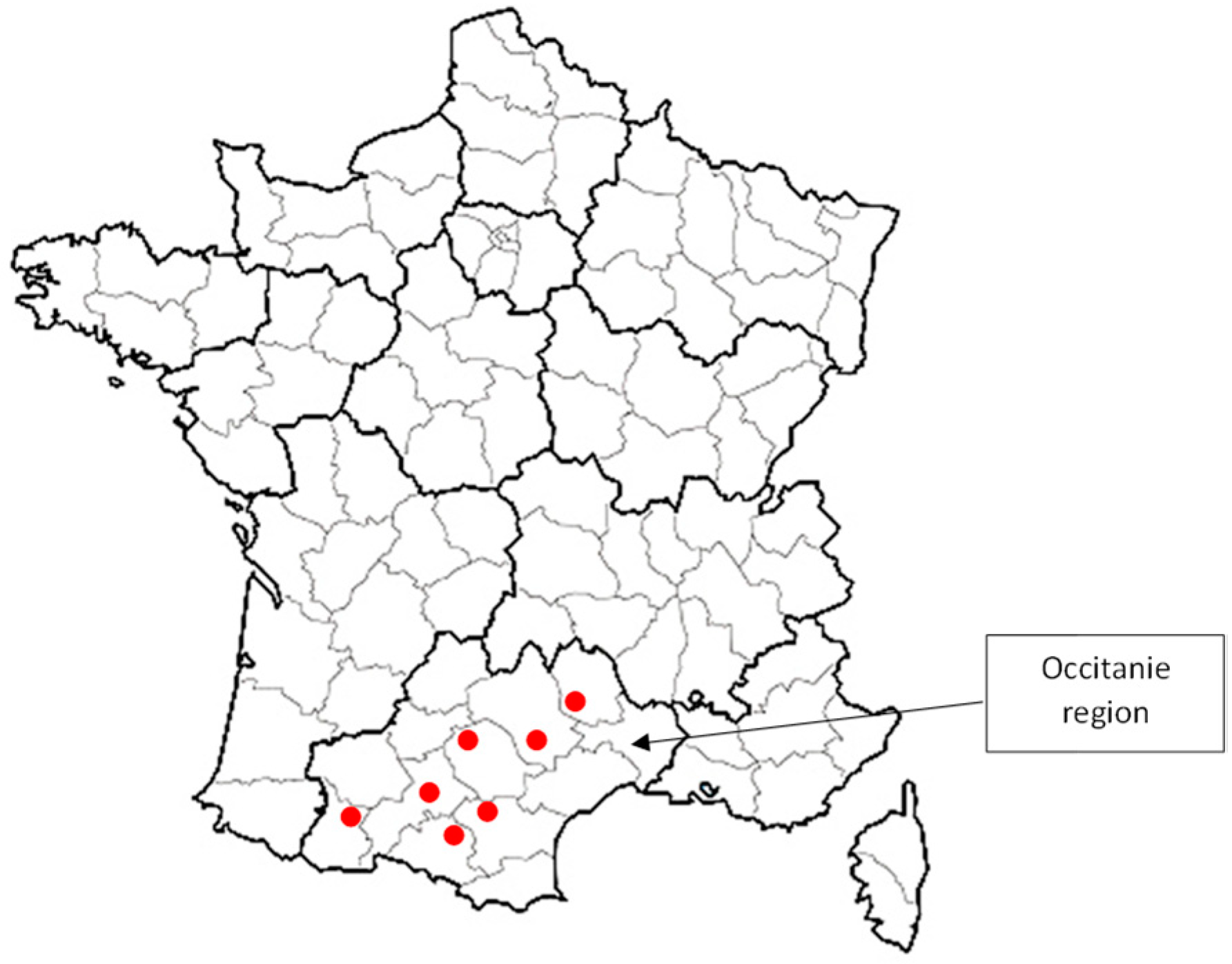
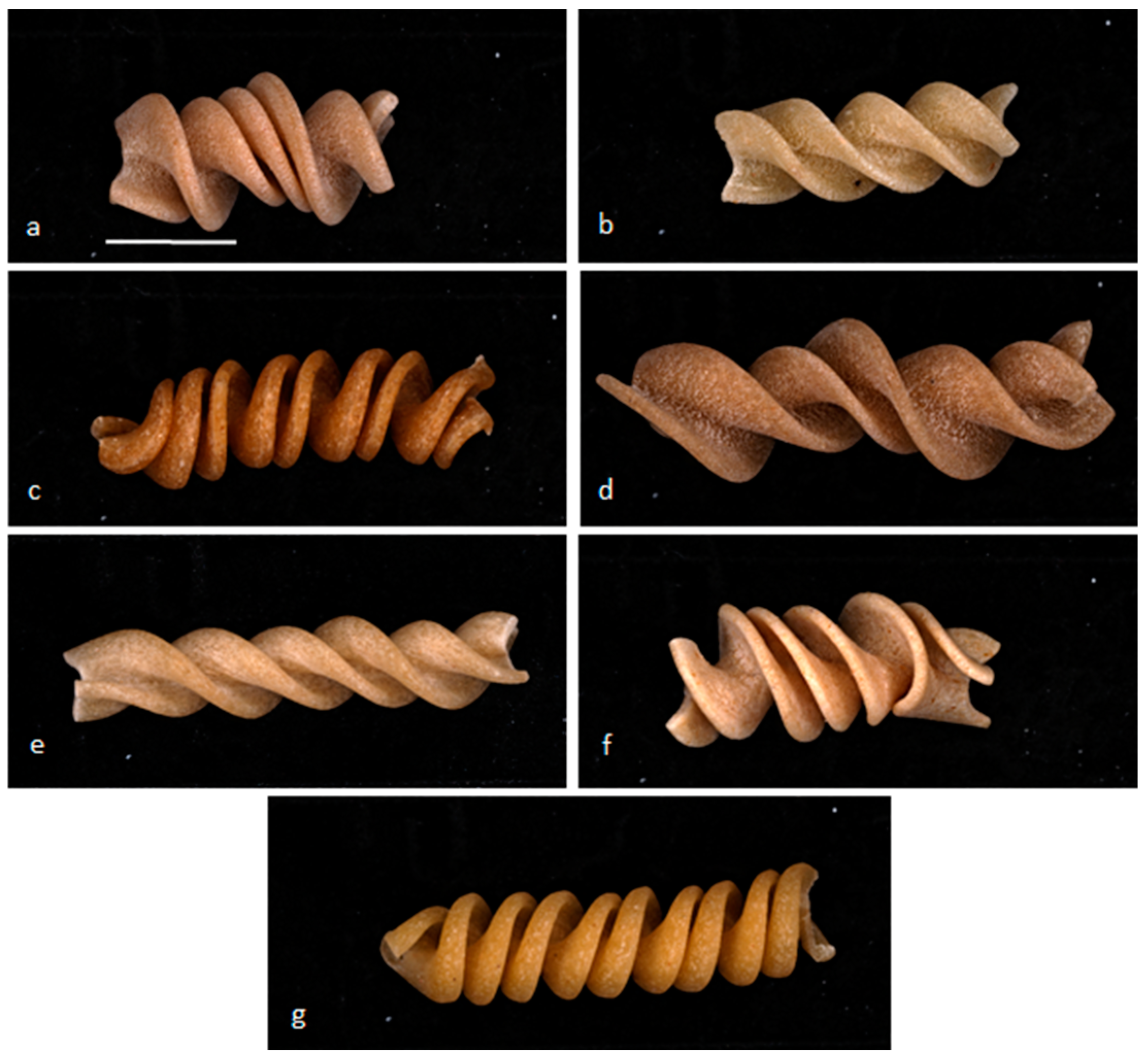
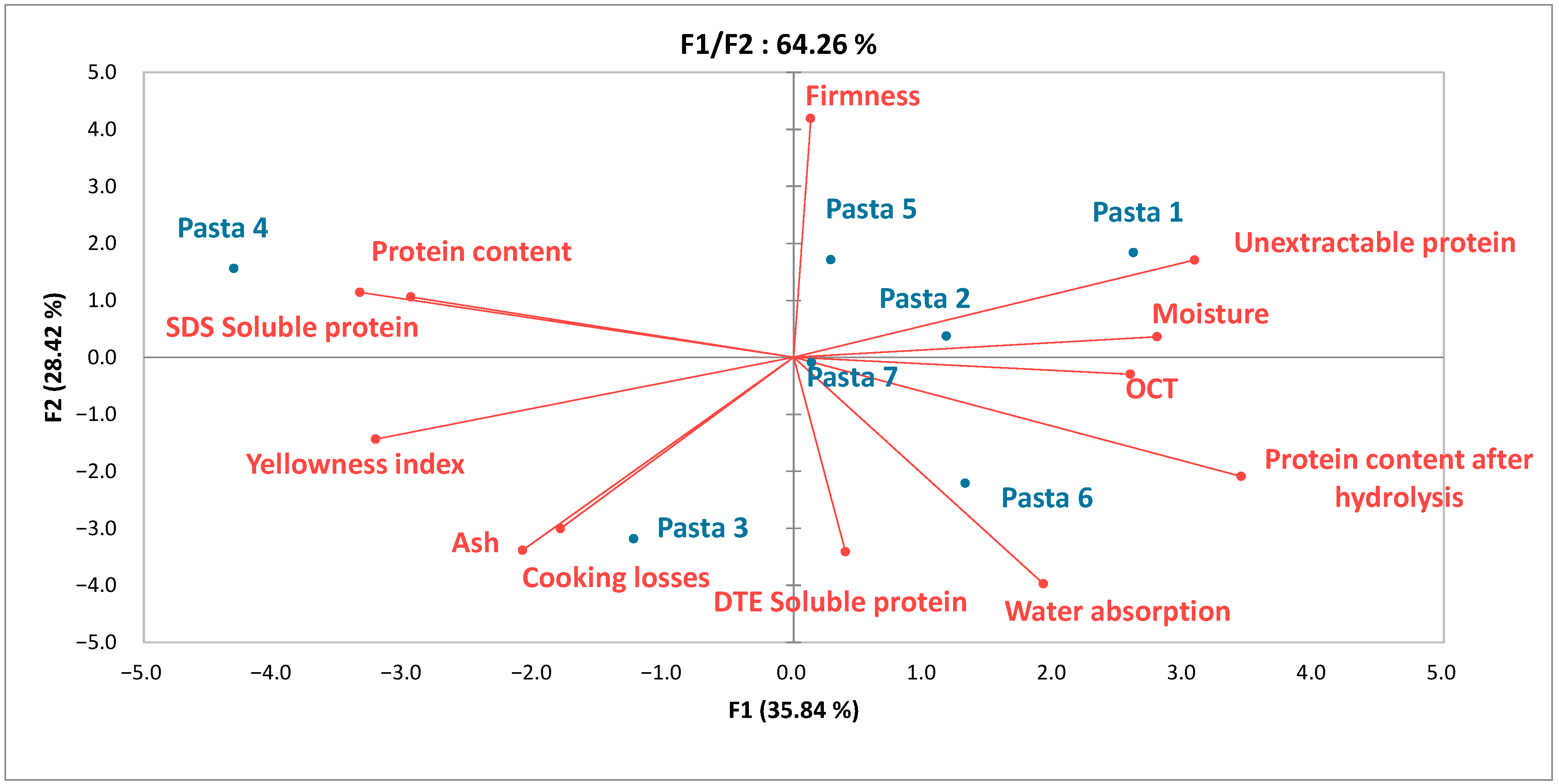
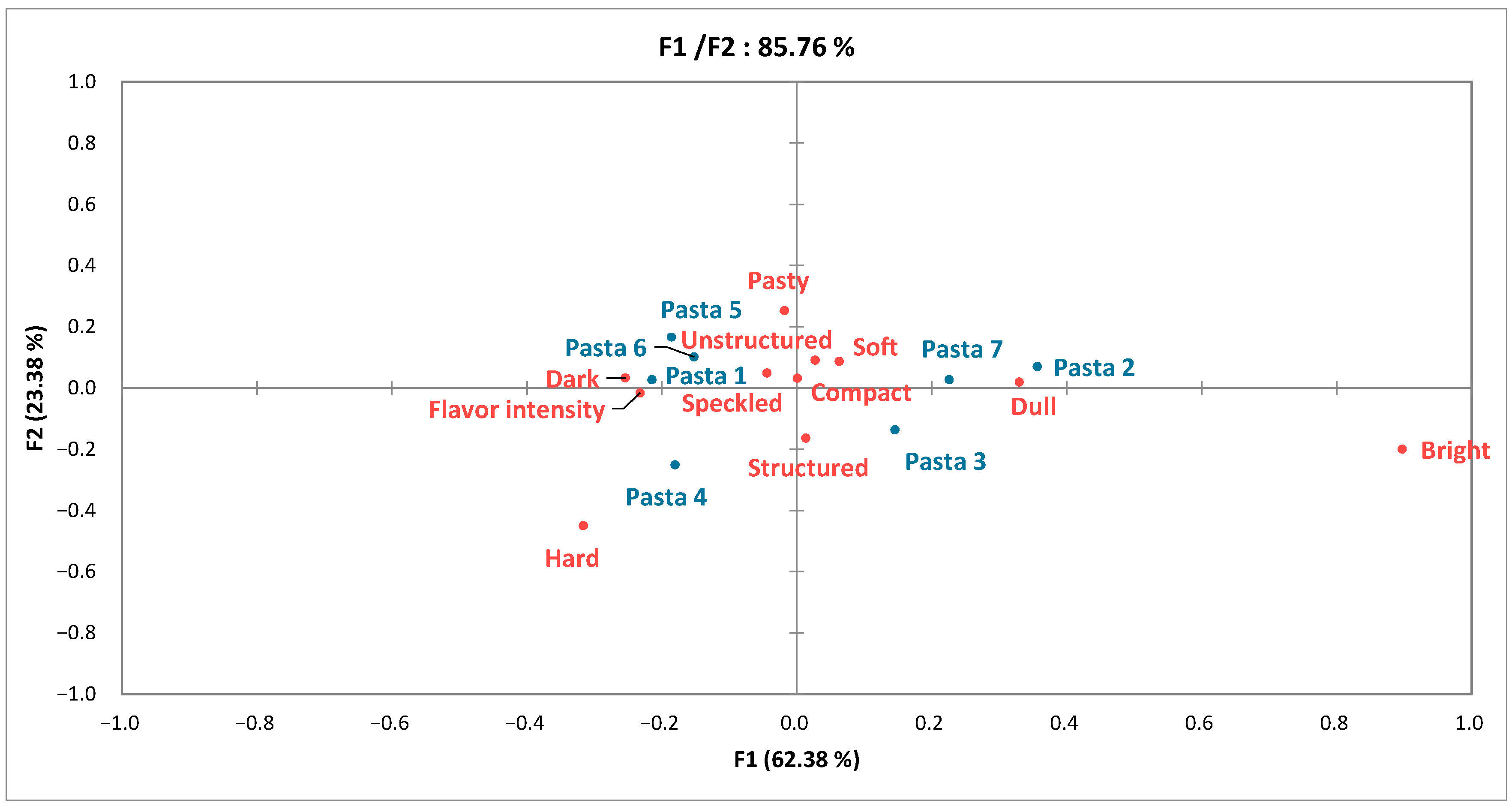
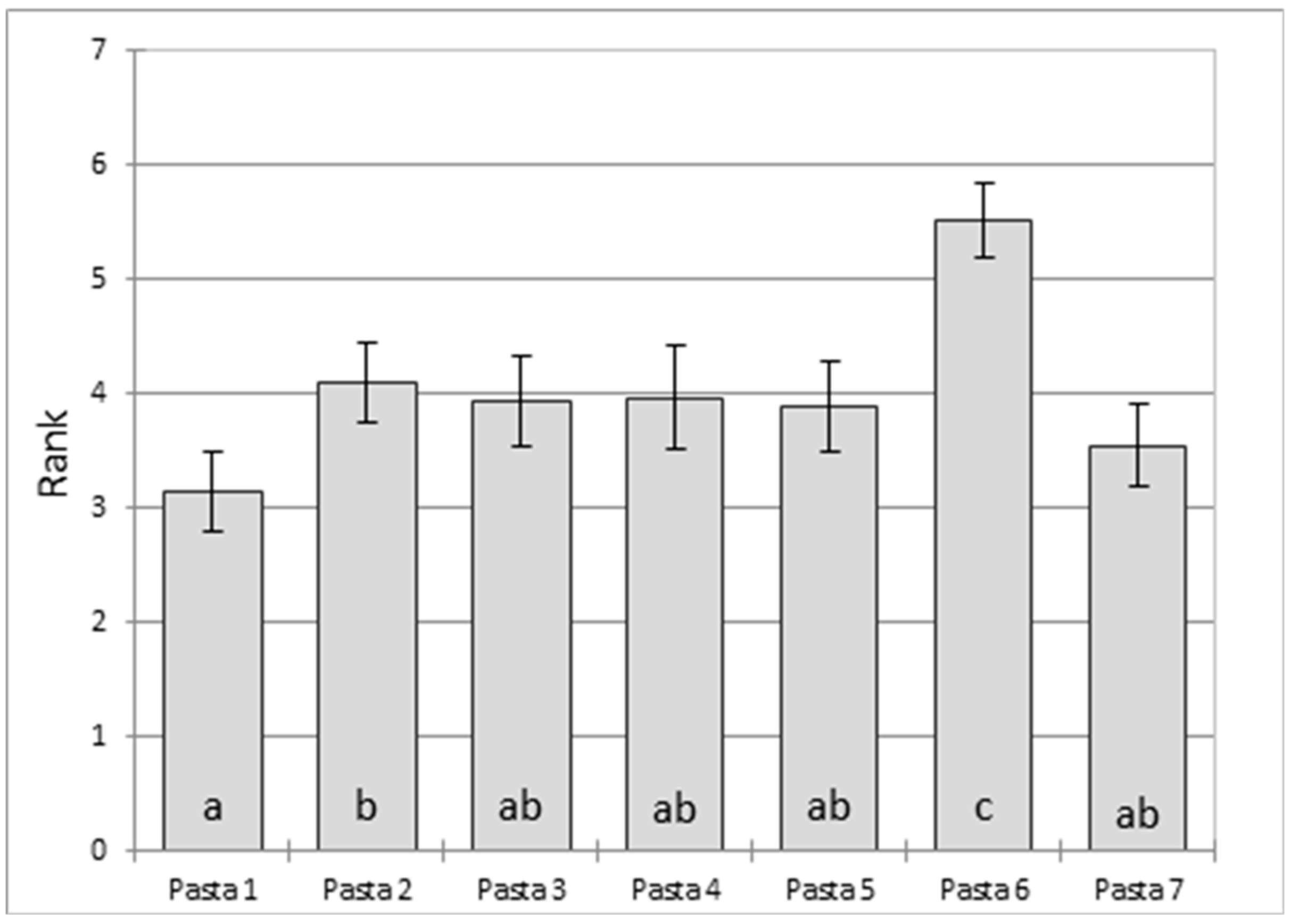
| Sample Number | Unit of Production | Type of Agriculture | Type of Wheat Used | Type of Milling | Die Material |
|---|---|---|---|---|---|
| 1 | Small-scale cooperative processing unit | Organic | Rivet wheat *,o | Stone milling | Bronze |
| 2 | Individual small-scale farmer–processor | Organic | Bidi17 o, Senatore Capelli o, LA1823 m | Stone milling | Bronze |
| 3 | Association of farmers and small-scale miller and pasta maker | Conventional | Voilur m, Anvergur m | Stone milling | Teflon |
| 4 | Association of farmers and small-scale miller and pasta maker | Organic | Atoudur m | Stone milling | Bronze |
| 5 | Individual small-scale farmer–processor | Organic | LA1823 m, Anvergur m | Roller milling | Teflon |
| 6 | Association of farmers and small-scale miller and pasta maker | Organic | Own mix of durum wheat (~40 varieties) mixed at sowing time | Stone milling | Bronze |
| 7 | Association of farmers and small-scale pasta maker | Conventional | Miradoux m, Anvergur m | Roller milling | Teflon |
| Samples | Dry Pasta | Cooked Pasta | |||||||||||||
|---|---|---|---|---|---|---|---|---|---|---|---|---|---|---|---|
| Moisture (%) | Ash (g/100 g DM) | Color | Firmness (N) | OCT (min) | Water Absorption (%) | Cooking Losses (%) | Protein Content (g/100 g DM) | SDS-Soluble Protein (%) | DTE-Soluble Protein (%) | Unextractable Protein (%) | Protein Content After Proteolysis (%) | ||||
| L* | a* | b* | Yellowness Index | ||||||||||||
| Pasta 1 | 8.79 a | 1.00 a | 70.09 bc | 3.95 d | 19.93 a | 40.62 bc | 89.80 a | 11.50 f | 158.3 abc | 11.20 | 11.25 | 24.59 | 60.41 | 14.99 | 79.34 |
| Pasta 2 | 8.30 ab | 1.56 abc | 74.46 de | 2.84 b | 19.66 a | 37.73 a | 99.75 a | 8.85 cd | 166.1 bc | 11.47 | 11.32 | 22.62 | 66.80 | 10.58 | 80.29 |
| Pasta 3 | 8.12 bc | 1.63 bc | 67.46 ab | 4.76 g | 23.26 c | 49.25 e | 61.06 c | 7.16 a | 196.3 d | 14.25 | 11.92 | 28.02 | 71.96 | 0.03 | 80.82 |
| Pasta 4 | 7.38 d | 1.66 bc | 66.88 a | 4.24 e | 22.15 bc | 47.31 cd | 91.05 a | 7.53 bc | 123.9 a | 14.02 | 13.39 | 39.82 | 57.40 | 2.78 | 64.37 |
| Pasta 5 | 8.11 bc | 1.30 ab | 67.36 a | 4.44 f | 22.62 bc | 47.96 de | 94.57 a | 6.00 a | 152.7 ab | 11.50 | 10.76 | 31.71 | 58.30 | 9.99 | 79.82 |
| Pasta 6 | 7.99 cd | 1.88 c | 74.01 cd | 2.95 c | 20.62 ab | 39.80 ab | 63.88 bc | 11.00 ef | 196.7 d | 15.01 | 9.84 | 27.62 | 60.98 | 11.40 | 81.84 |
| Pasta 7 | 7.18 d | 1.29 ab | 75.78 e | 2.03 a | 24.22 c | 43.77 bc | 73.43 b | 9.83 de | 189.4 cd | 12.56 | 13.07 | 21.43 | 61.63 | 16.93 | 75.35 |
| Mean | 7.98 | 1.47 | 70.86 | 3.60 | 21.78 | 43.96 | 81.93 | 8.84 | 169.0 | 12.86 | 11.65 | 27.97 | 62.50 | 9.53 | 77.40 |
| SD | 0.55 | 0.29 | 3.82 | 1.00 | 1.74 | 3.56 | 15.58 | 2.05 | 26.9 | 1.56 | 1.26 | 6.29 | 5.15 | 6.13 | 6.10 |
| Category | Descriptors | Pasta 1 | Pasta 2 | Pasta 4 | Pasta 5 | Pasta 6 | Pasta 7 |
|---|---|---|---|---|---|---|---|
| Visual Appearance | Bright | 6 (−) | 52 (+) | 11 | 0 (−) | 2 (−) | 46 (+) |
| Yellow | 43 | 61 | 61 (+) | 46 | 52 | 37 | |
| Dark | 65 (+) | 19 (−) | 47 | 60 | 61 | 42 | |
| Structured | 38 | 43 | 63 (+) | 40 | 38 | 48 | |
| Speckled | 61 | 50 | 51 | 57 | 61 | 58 | |
| Unstructured | 54 | 55 | 37 | 53 | 51 | 48 | |
| Compact | 51 | 47 | 42 | 48 | 50 | 48 | |
| Texture in mouth | Hard | 43 (+) | 5 (−) | 53 (+) | 19 | 27 | 12 (−) |
| Pasty | 55 | 46 | 13 (−) | 60 (+) | 51 | 35 | |
| Soft | 52 | 60 | 42 | 55 | 55 | 60 | |
| Grainy | 61 | 52 | 55 | 53 | 57 | 48 | |
| Melting | 42 | 57 | 51 | 54 | 53 | 56 | |
| Flavor | Dull | 21 (−) | 53 (+) | 22 (−) | 25 | 35 | 45 (+) |
| Flavor intensity | 70 | 35 (−) | 74 (+) | 76 (+) | 64 | 49 | |
| Salty | 48 | 52 | 49 | 56 | 53 | 51 |
Publisher’s Note: MDPI stays neutral with regard to jurisdictional claims in published maps and institutional affiliations. |
© 2022 by the authors. Licensee MDPI, Basel, Switzerland. This article is an open access article distributed under the terms and conditions of the Creative Commons Attribution (CC BY) license (https://creativecommons.org/licenses/by/4.0/).
Share and Cite
Belahcen, L.; Cassan, D.; Canaguier, E.; Robin, M.-H.; Chiffoleau, Y.; Samson, M.-F.; Jard, G. Physicochemical and Sensorial Characterization of Artisanal Pasta from the Occitanie Region in France. Foods 2022, 11, 3208. https://doi.org/10.3390/foods11203208
Belahcen L, Cassan D, Canaguier E, Robin M-H, Chiffoleau Y, Samson M-F, Jard G. Physicochemical and Sensorial Characterization of Artisanal Pasta from the Occitanie Region in France. Foods. 2022; 11(20):3208. https://doi.org/10.3390/foods11203208
Chicago/Turabian StyleBelahcen, Loubnah, Denis Cassan, Elodie Canaguier, Marie-Hélène Robin, Yuna Chiffoleau, Marie-Françoise Samson, and Gwénaëlle Jard. 2022. "Physicochemical and Sensorial Characterization of Artisanal Pasta from the Occitanie Region in France" Foods 11, no. 20: 3208. https://doi.org/10.3390/foods11203208
APA StyleBelahcen, L., Cassan, D., Canaguier, E., Robin, M.-H., Chiffoleau, Y., Samson, M.-F., & Jard, G. (2022). Physicochemical and Sensorial Characterization of Artisanal Pasta from the Occitanie Region in France. Foods, 11(20), 3208. https://doi.org/10.3390/foods11203208






